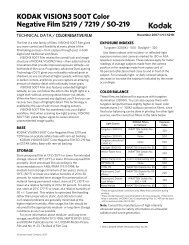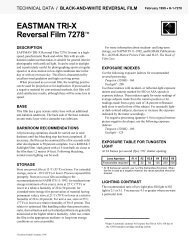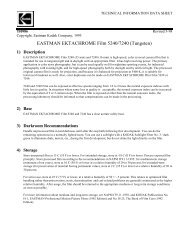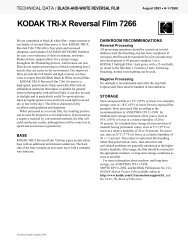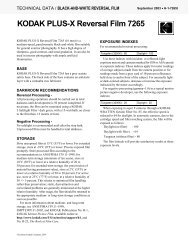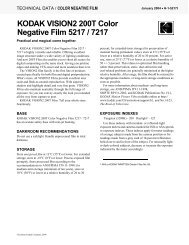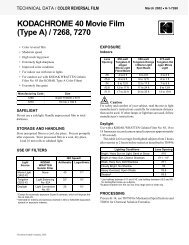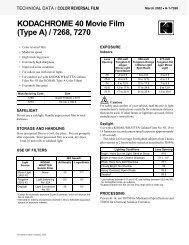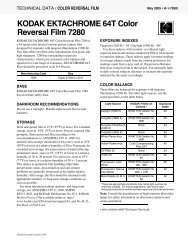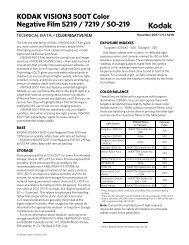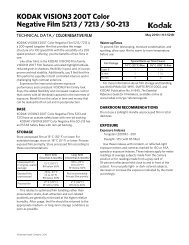KODAK VISION3 200T Color Negative Film 5213 / 7213 / SO-213
KODAK VISION3 200T Color Negative Film 5213 / 7213 / SO-213
KODAK VISION3 200T Color Negative Film 5213 / 7213 / SO-213
You also want an ePaper? Increase the reach of your titles
YUMPU automatically turns print PDFs into web optimized ePapers that Google loves.
print films, the LAD patch is printed to a neutral gray of 1.0<br />
visual density. For duplicating films, the specified aims are<br />
at the center of the usable straight-line portion of the<br />
sensitometric curve of the film.<br />
Due to normal variations in exposure and processing of<br />
color negative films, particular scenes may not print<br />
exactly at the same printer lights as the LAD Control <strong>Film</strong>.<br />
The LAD Control <strong>Film</strong> is intended as a set-up tool for<br />
electronic color analyzers and printers. It is NOT a<br />
reference that every scene must match. Normal<br />
film-to-film and scene-to-scene exposure variability is<br />
accommodated by the color timing (grading) process, on<br />
an electronic color analyzer set up with the LAD Control<br />
<strong>Film</strong>. Normally exposed and processed color negatives will<br />
typically print well within the range of an additive printer<br />
setup with the LAD Control <strong>Film</strong>, although SIGNIFICANT<br />
or UNEXPECTED departures from this center point<br />
balance may indicate an exposure/filtration problem with<br />
the cinematography or with the process control. Some<br />
specialized films and/or specialized negative processing<br />
techniques (push-processing, pull-processing,<br />
"skip-bleach" processing, etc.) may require more extreme<br />
adjustment from the LAD printing condition to attain<br />
desired results.<br />
More information about LAD and Digital LAD is<br />
available online at www.kodak.com/go/lad.<br />
<strong>Film</strong>-to-Tape Transfers<br />
When you transfer the film directly to tape, you can set up<br />
the telecine using <strong>KODAK</strong> Telecine Analysis <strong>Film</strong> (TAF)<br />
supplied by Eastman Kodak Company. The TAF consists of<br />
a neutral density scale and an eight-bar color test pattern<br />
with a LAD gray surround.<br />
The TAF gray scale provides the telecine operator<br />
(colorist) with an effective way to adjust subcarrier<br />
balance and to center the telecine controls before timing<br />
and transferring a film. The TAF color bars provide the<br />
utility of electronic color bars, even though they do not<br />
precisely match the electronically generated color bars.<br />
Using the TAF will help obtain optimum quality and<br />
consistency in the film-to-tape transfer. For more<br />
information regarding TAF, see <strong>KODAK</strong> Publication No.<br />
H-606, <strong>KODAK</strong> Telecine Tool Kit and Reference Manual,<br />
available online at www.kodak.com/go/telecine.<br />
IMAGE STRUCTURE<br />
For more information on image-structure characteristics,<br />
see <strong>KODAK</strong> Publication No. H-845, The Essential Reference<br />
Guide for <strong>Film</strong>makers available online at www.kodak.com/<br />
go/referenceguide.<br />
Important<br />
The sensitometric curves and data in this publication<br />
represent product tested under the conditions of exposure<br />
and processing specified. They are representative of<br />
production coatings, and therefore do not apply directly to<br />
a particular box or roll of photographic material. They do<br />
not represent standards or specifications that must be met<br />
by Eastman Kodak Company. The company reserves the<br />
right to change and improve product characteristics at any<br />
time.<br />
Modulation Transfer Function<br />
The "perceived" sharpness of any film depends on various<br />
components of the motion picture production system. The<br />
camera and projector lenses and film printers, among other<br />
factors, all play a role. But the specific sharpness of a film<br />
can be measured and is charted in the Modulation Transfer<br />
Function Curve.<br />
RESPONSE (%)<br />
200<br />
100<br />
70<br />
50<br />
30<br />
20<br />
10<br />
7<br />
5<br />
3<br />
2<br />
Modulation-Transfer Function Curves<br />
Process: ECN-2<br />
Densitometry: Status M<br />
Exposure: 3200K Tungsten<br />
1 2 3 4 5 10 20 50 100 200 600<br />
SPATIAL FREQUENCY (cycles/mm)<br />
This graph shows a measure of the visual sharpness of<br />
this film. The x-axis, "Spatial Frequency," refers to the<br />
number of sine waves per millimeter that can be resolved.<br />
The y-axis, "Response," corresponds to film sharpness.<br />
The longer and flatter the line, the more sine waves per<br />
millimeter that can be resolved with a high degree of<br />
sharpness—and, the sharper the film.<br />
G B<br />
R<br />
<strong>KODAK</strong> <strong>VISION3</strong> <strong>200T</strong> <strong>Color</strong> <strong>Negative</strong> <strong>Film</strong> <strong>5<strong>213</strong></strong> / <strong>7<strong>213</strong></strong> / <strong>SO</strong>-<strong>213</strong> • H-1-<strong>5<strong>213</strong></strong>t 3


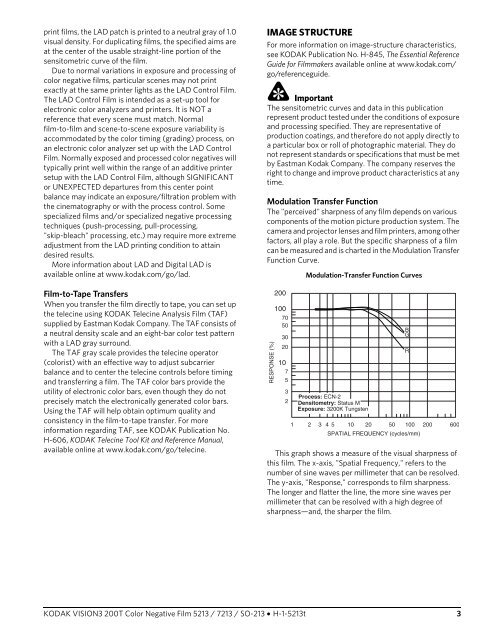
![FUJICHROME ASTIA 100F Professional [RAP100F] - Wittner ...](https://img.yumpu.com/27567144/1/190x253/fujichrome-astia-100f-professional-rap100f-wittner-.jpg?quality=85)
